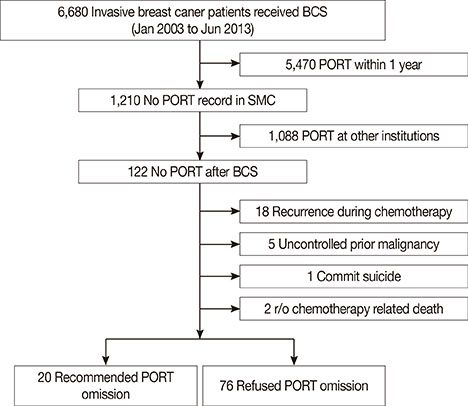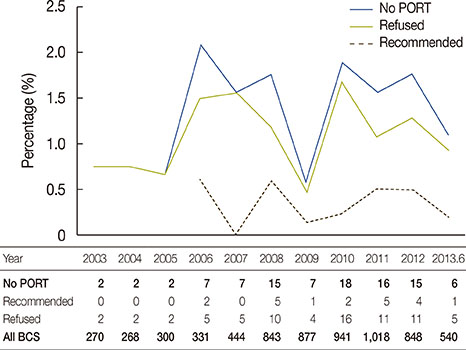J Breast Cancer.
2015 Mar;18(1):50-56. 10.4048/jbc.2015.18.1.50.
Proportion and Clinical Outcomes of Postoperative Radiotherapy Omission after Breast-Conserving Surgery in Women with Breast Cancer
- Affiliations
-
- 1Department of Radiation Oncology, Samsung Medical Center, Sungkyunkwan University School of Medicine, Seoul, Korea. doho.choi@samsung.com
- 2Department of Surgery, Samsung Medical Center, Sungkyunkwan University School of Medicine, Seoul, Korea.
- 3Department of Medicine, Samsung Medical Center, Sungkyunkwan University School of Medicine, Seoul, Korea.
- KMID: 2286337
- DOI: http://doi.org/10.4048/jbc.2015.18.1.50
Abstract
- PURPOSE
The present study was conducted to investigate the proportion and clinical outcomes of breast cancer patients who did not receive postoperative radiotherapy (PORT) after breast-conserving surgery (BCS).
METHODS
This retrospective study included all breast cancer patients received curative BCS without PORT between 2003 and 2013. In the PORT omission group, characteristics and local recurrence differences were compared between the recommended group and the refused group. To compare the local recurrence-free survival (LRFS) of the PORT omission group and the control group who received PORT, subjects were selected by using the pooled data of patients treated between 1994 and 2007.
RESULTS
During the study period, 96 patients did not receive PORT among a total of 6,680 patients who underwent BCS. Therefore, the overall rate of PORT omission was 1.4%. Among the 96 patients, 20 were recommended for PORT omission (recommended group) and 76 refused PORT (refused group). The median follow-up period of all study participants was 19.3 months (range, 0.3-115.1 months). Patients in the recommended group were older (p=0.004), were more likely to be postmenopausal (p=0.013), and had more number of positive prognostic factors compared with the refused group. Overall, 12 cases of disease recurrence, including 11 cases of local recurrence, developed in the PORT-refused group. The LRFS of the PORT-omission group was significantly inferior to that of patients who received PORT after BCS (p<0.001). In the PORT-omission group, significant favorable prognostic factors for LRFS were having histologic grade 1 or 2 disease (p=0.023), having no axillary lymph node metastasis (p=0.039), receiving adjuvant endocrine therapy (p=0.046), and being in the recommended group (p=0.026).
CONCLUSION
The rate of PORT omission in the present study is very low among women who underwent surgery compared to that of other studies worldwide. PORT omission is significantly related to a high local recurrence rate.
Keyword
MeSH Terms
Figure
Reference
-
1. DeSantis C, Siegel R, Bandi P, Jemal A. Breast cancer statistics, 2011. CA Cancer J Clin. 2011; 61:409–418.
Article2. Jemal A, Bray F, Center MM, Ferlay J, Ward E, Forman D. Global cancer statistics. CA Cancer J Clin. 2011; 61:69–90.
Article3. Jung KW, Won YJ, Kong HJ, Oh CM, Lee DH, Lee JS. Cancer statistics in Korea: incidence, mortality, survival, and prevalence in 2011. Cancer Res Treat. 2014; 46:109–123.
Article4. Korean Breast Cncer Society. Breast Cancer White Paper. Seoul: Korean Breast Cancer Society;2013.5. Early Breast Cancer Trialists' Collaborative Group (EBCTCG). Darby S, McGale P, Correa C, Taylor C, Arriagada R, et al. Effect of radiotherapy after breast-conserving surgery on 10-year recurrence and 15-year breast cancer death: meta-analysis of individual patient data for 10,801 women in 17 randomised trials. Lancet. 2011; 378:1707–1716.
Article6. Cinical practice guidelines in oncology: breast cancer. National Comprehensive Cancer Network;2014. Accessed October 1st, 2014. http://www.nccn.org/professionals/physician_gls/f_guidelines.asp.7. National Institute for Health and Clinical Excellence. National Collaborating Centre for Cancer. Early and Locally Advanced Breast Cancer: Diagnosis and Treatment. London: National Institute for Health and Clinical Excellence;2009.8. Nattinger AB, Hoffmann RG, Kneusel RT, Schapira MM. Relation between appropriateness of primary therapy for early-stage breast carcinoma and increased use of breast-conserving surgery. Lancet. 2000; 356:1148–1153.
Article9. Badakhshi H, Gruen A, Sehouli J, Budach V, Boehmer D. The impact of patient compliance with adjuvant radiotherapy: a comprehensive cohort study. Cancer Med. 2013; 2:712–717.
Article10. White J. Do we need to irradiate all small invasive breast cancers and DCIS? Am Soc Clin Oncol Educ Book. 2013; 40–44.
Article11. Colleoni M, Rotmensz N, Peruzzotti G, Maisonneuve P, Viale G, Renne G, et al. Minimal and small size invasive breast cancer with no axillary lymph node involvement: the need for tailored adjuvant therapies. Ann Oncol. 2004; 15:1633–1639.
Article12. Kim H, Noh JM, Choi DH, Lee J, Nam SJ, Lee JE, et al. Excision alone for small size ductal carcinoma in situ of the breast. Breast. 2014; 23:586–590.
Article13. Hughes KS, Schnaper LA, Berry D, Cirrincione C, McCormick B, Shank B, et al. Lumpectomy plus tamoxifen with or without irradiation in women 70 years of age or older with early breast cancer. N Engl J Med. 2004; 351:971–977.
Article14. Lim YJ, Kim K, Chie EK, Han W, Noh DY, Ha SW. Treatment outcome of ductal carcinoma in situ patients treated with postoperative radiation therapy. Radiat Oncol J. 2014; 32:1–6.
Article15. Cheang MC, Voduc D, Bajdik C, Leung S, McKinney S, Chia SK, et al. Basal-like breast cancer defined by five biomarkers has superior prognostic value than triple-negative phenotype. Clin Cancer Res. 2008; 14:1368–1376.
Article16. Showalter SL, Grover S, Sharma S, Lin L, Czerniecki BJ. Factors influencing surgical and adjuvant therapy in stage I breast cancer: a SEER 18 database analysis. Ann Surg Oncol. 2013; 20:1287–1294.
Article17. Fisher B, Bryant J, Dignam JJ, Wickerham DL, Mamounas EP, Fisher ER, et al. Tamoxifen, radiation therapy, or both for prevention of ipsilateral breast tumor recurrence after lumpectomy in women with invasive breast cancers of one centimeter or less. J Clin Oncol. 2002; 20:4141–4149.
Article18. Fyles AW, McCready DR, Manchul LA, Trudeau ME, Merante P, Pintilie M, et al. Tamoxifen with or without breast irradiation in women 50 years of age or older with early breast cancer. N Engl J Med. 2004; 351:963–970.
Article19. Hughes KS, Schnaper LA, Bellon JR, Cirrincione CT, Berry DA, McCormick B, et al. Lumpectomy plus tamoxifen with or without irradiation in women age 70 years or older with early breast cancer: long-term follow-up of CALGB 9343. J Clin Oncol. 2013; 31:2382–2387.
Article20. Tuttle TM, Jarosek S, Habermann EB, Yee D, Yuan J, Virnig BA. Omission of radiation therapy after breast-conserving surgery in the United States: a population-based analysis of clinicopathologic factors. Cancer. 2012; 118:2004–2013.
Article21. Bane AL, Whelan TJ, Pond GR, Parpia S, Gohla G, Fyles AW, et al. Tumor factors predictive of response to hypofractionated radiotherapy in a randomized trial following breast conserving therapy. Ann Oncol. 2014; 25:992–998.
Article22. Zhou W, Jirström K, Amini RM, Fjällskog ML, Sollie T, Lindman H, et al. Molecular subtypes in ductal carcinoma in situ of the breast and their relation to prognosis: a population-based cohort study. BMC Cancer. 2013; 13:512.
Article23. Caudle AS, Yu TK, Tucker SL, Bedrosian I, Litton JK, Gonzalez-Angulo AM, et al. Local-regional control according to surrogate markers of breast cancer subtypes and response to neoadjuvant chemotherapy in breast cancer patients undergoing breast conserving therapy. Breast Cancer Res. 2012; 14:R83.
Article24. Pötter R, Gnant M, Kwasny W, Tausch C, Handl-Zeller L, Pakisch B, et al. Lumpectomy plus tamoxifen or anastrozole with or without whole breast irradiation in women with favorable early breast cancer. Int J Radiat Oncol Biol Phys. 2007; 68:334–340.
Article25. Jeong Y, Kim SS, Gong G, Lee HJ, Ahn SH, Son BH, et al. Treatment results of breast cancer patients with locoregional recurrence after mastectomy. Radiat Oncol J. 2013; 31:138–146.
Article
- Full Text Links
- Actions
-
Cited
- CITED
-
- Close
- Share
- Similar articles
-
- Body Image and Physical suffering during Radiotherapy in Breast Cancer Patients Following Breast Conserving Operations
- Radiotherapy for Breast Cancer
- Comparison of Psychiatric Symptoms between Total Mastectomy and Breast Conserving Surgery in Breast Cancer Patients
- Oncoplastic Breast Surgery
- Interactions of Family History of Breast Cancer with Radiotherapy in Relation to the Risk of Breast Cancer Recurrence





